- Top 15 project scheduling software comparison
- Zoho Projects: Best for teams needing an all-in-one solution
- monday work management: Best for teams of all skill levels
- Wrike: Best for versatility
- Paymo: Best for small businesses
- Notion: Best for remote teams
- Adobe Workfront: Best for Adobe product users
- TeamGantt: Best for large teams
- Kantata: Best for automation
- Celoxis: Best for complicated or high-uncertainty situations
- Parallax: Best for predictive resource management
- Runn: Best for IT, architecture and engineering teams
- Nifty: Best for managing task dependencies and milestones
- GanttPRO: Best for budget management and automatic rescheduling
- Resource Guru: Best for affordability and workload management
- Key features of project scheduling software
- Work breakdown features
- More project management coverage
- Gantt charts
- Integrations
- Timeline view
- Documentation and reporting
- How do I choose the best project scheduling software for my business?
- Methodology
- Best for teams needing an all-in-one solution: Zoho Projects
- Best for teams of all skill levels: monday work management
- Best for versatility: Wrike
- Best for small businesses: Paymo
- Best for remote teams: Notion
- Best for Adobe product users: Adobe Workfront
- Best for teams using other Microsoft tools: Microsoft Project
- Best for large teams: TeamGantt
- Best for automation: Kantata
- Best for complicated or high-uncertainty situations: Celoxis
- Best for predictive resource management: Parallax
- Best for IT, architecture and engineering teams: Runn
- Best for managing task dependencies and milestones: Nifty
- Best for budget management and automatic rescheduling: GanttPRO
- Best for affordability and workload management: Resource Guru
Project management scheduling software provides an excellent way to manage your time and keep track of your team’s progress. However, different businesses have varying needs, so finding the ideal solution requires some careful forethought.
To help, here’s an overview of some of the best project management scheduling software available today.
Top 15 project scheduling software comparison
Here is a head-to-head feature and pricing comparison chart of the best project scheduling software and tools.
| Free plan | Starting price (per month) | Gantt charts | Resource management | Automations | Time tracking | |
|---|---|---|---|---|---|---|
| Zoho Projects | Yes | $5 | Yes | Yes | Yes | Yes |
| monday.com | Yes | $12 per user | Yes | Yes | Yes | Yes |
| Wrike | Yes | $9.80 per user | Yes | Yes | Yes | Yes |
| Paymo | Yes | $9.9 per user | Yes | Yes | Yes | Yes |
| Notion | Yes | $10 per user | Yes | Yes | Yes | Yes |
| Adobe Workfront | No | N/A | Yes | Yes | Yes | Yes |
| Microsoft Project | No | $10 per user | Yes | Yes | Yes | Yes |
| TeamGantt | Yes | $24 per user | Yes | Yes | Yes | Only in Pro and Enterprise plans |
| Kantata | No | N/A | Yes | Yes | Yes | Yes |
| Celoxis | No | N/A | Yes | Yes | Yes | Yes |
| Parallax | No | N/A | Yes | Yes | Yes | Yes |
| Runn | Yes | $10 per user | Yes | Yes | Yes | Via integration with Harvest and Clockify |
| Nifty | Yes | $49 for 10 members | Yes | Yes | Yes | Yes |
| GanttPRO | No | $9.99 per user | Yes | Yes | Yes | Yes |
| Resource Guru | No | $5 per user | Yes | Yes | Yes | Yes |
Zoho Projects: Best for teams needing an all-in-one solution
Zoho Projects naturally comes with several features, such as Kanban, Gantt charts, multiple list views, timelines and more. It’s possible to easily plan and assign tasks to team members through Zoho; plus, its workflow automation features can prevent slowdowns, making things far more efficient. It’s the ideal project scheduling software for teams that regularly distribute assignments to other members.
Why we chose Zoho Projects
Zoho Projects provides an intuitive scheduling platform for teams of all sizes. Its interactive Gantt charts give project managers the ability to easily visualize schedules, identify bottlenecks and manage task dependencies. The most significant feature is its ability to interact with other Zoho applications, which creates a convenient ecosystem of tools for teams to use in all aspects of their business.
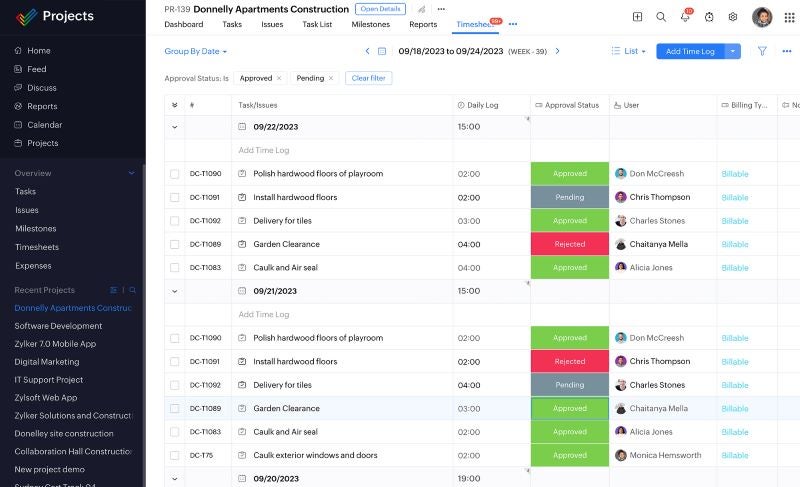
Pricing
- Free: For up to 3 users.
- Premium: $4 per user per month, billed yearly; or $5 per user per month, billed month-to-month.
- Enterprise: $9 per user per month, billed yearly; or $10 per user per month, billed month-to-month.
Features
- Custom Views: Designed to fit your project management workflow.
- Workflow Automation: With Blueprint, users can automate follow-up and hands-off tasks.
- Budgeting: Get a clear scope of your project budget in line with your current workflow.
Integrations
- Google Apps: Integrate Calendar, Spreadsheets and Drive files into your scheduling workflow.
- Microsoft Apps: Integrate Excel, SharePoint, OneDrive and other Microsoft tools into your process.
- Zoho apps: Improve your project scheduling software by adding Analytics, Sprints and other Zoho apps to better communicate and streamline tasks.
| Pros | Cons |
|---|---|
|
|
For more information, read the full Zoho Projects review.
monday work management: Best for teams of all skill levels

monday work management is one of the most popular project management scheduling tools today, and it’s easy to see why. It has an attractive interface and is easy to use while offering a wide array of features. This balance between user-friendliness and technical ability makes it an ideal choice for teams with users of varying experience levels.
monday work management’s accessibility and price make it one of the best project management applications. Multiple automations and collaborative features help you keep your team on track and find bottlenecks in minimal time. If there’s one thing holding it back, it’s that some users say its pricing progression can be confusing.
Why we chose monday work management
monday work management comes with a list of features and is one of the most robust project scheduling tools currently available. The user-friendly interface makes it possible for a team, small or large, to integrate the software into its process with little to no hassle. Multiple integrations and customization features allow project managers to make monday as complex or simple as they like to best fit their project workflow.
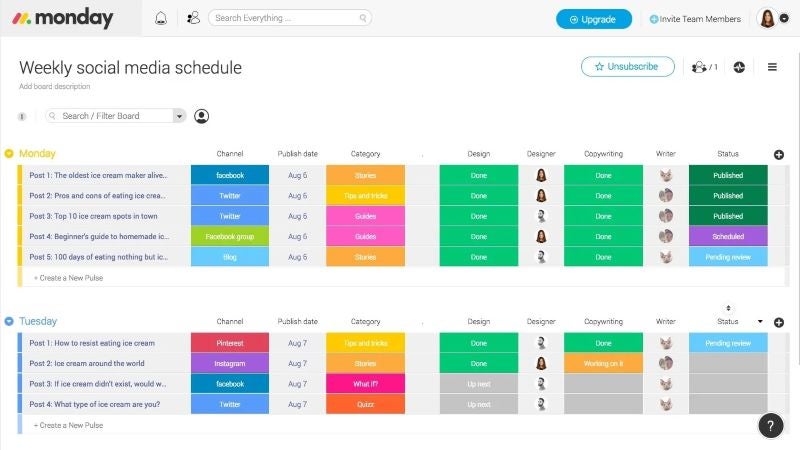
Pricing
- Free: No cost for two users.
- Basic: $9 per user per month, billed annually; or $12 per user per month, billed monthly.
- Standard: $12 per user per month, billed annually; or $14 per user per month, billed monthly.
- Pro: $19 per user per month, billed annually; or $24 per user per month, billed monthly.
- Enterprise: Contact monday work management for pricing.
Features
- Real-time collaboration: Offers one shared workspace, so team members are always connected.
- Multiple project views: Allows managers to track all projects in one place and delegate tasks as needed.
- Integrations: Integrates with many popular apps like Slack and Google Drive for a unified project management platform.
Integrations
- Slack: Receive real-time notifications and updates on projects.
- Jira: Stay connected to development workflows and track issues and bugs.
- Google Workspace: Access and incorporate all of Google’s suite of software, such as Docs and Sheets.
| Pros | Cons |
|---|---|
|
|
For more information, read the full monday work management review.
Wrike: Best for versatility

Wrike claims to do it all, and it certainly has the features to back it up. The platform has more than 400 third-party integrations, and its dashboards are highly configurable.
Drag-and-drop Gantt charts, 24/7 technical support and customizable automated workflows make Wrike one of the most versatile tools available. That versatility comes at the cost of not specializing in any specific purpose, but that can be useful for teams with frequently changing needs.
Why we chose Wrike
Wrike’s collaborative features allow teams to easily create, assign and track tasks on a single platform. Through its real-time activity stream, team members constantly receive updates and information on the progress and changes made to a project. These features make it ideal for project scheduling.
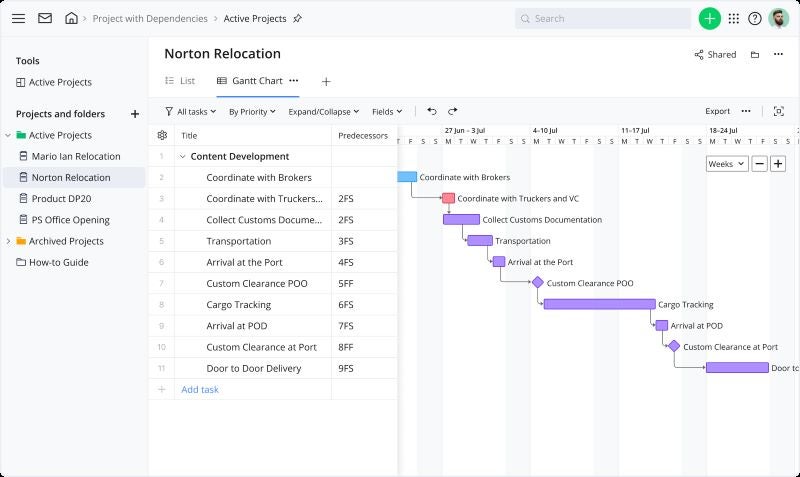
Pricing
- Free: No cost for individuals and small teams just getting started.
- Team: $9.80 per user per month for two to 25 users.
- Business: $24.80 per user per month for five to 500 users.
- Enterprise: Contact Wrike for pricing.
- Pinnacle: Contact Wrike for pricing.
Features
- Drag-and-drop Gantt charts: Managers can easily and quickly adjust project timelines and view project progress.
- Built-in data security: Sensitive company data is protected with Wrike’s data security features and policies.
- Dedicated mobile and desktop apps: Mobile and desktop apps allow team members to work from anywhere.
- Cross-tagging between projects: Departmental cross-tagging in projects allows for company-wide visibility.
Integrations
- Power BI: Receive advanced analytics and reporting for projects.
- Adobe Creative Cloud: Give feedback and approval on Adobe Creative tasks.
- GitHub: Sync between GitHub and Wrike tasks for easier visibility.
Pros
- Highly customizable.
- Hundreds of integrations.
- Free tier supports more than one user.
Cons
- Upper tiers can be expensive.
- Lack of focus can inhibit teams with specific needs.
| Pros | Cons |
|---|---|
|
|
For more information, read the full Wrike review.
Paymo: Best for small businesses
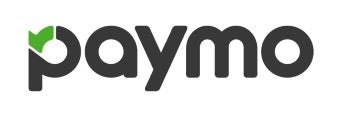
Paymo is designed for small businesses and freelancers, and that shows in its simplicity. Practical tools like automatic time-tracking and automated booking streamline tasks that would otherwise take a lot of time. Its colorful, blocky interface also makes it comfortable and easy to use.
Because of this focus, Paymo doesn’t have as many integrations with other apps as some of the more expensive options. However, it remains one of the best tools for smaller teams.
Why we chose Paymo
Paymo provides an all-in-one approach for small businesses needing a convenient environment for work scheduling and project management. The tool comes with several features to aid project managers with time tracking, scheduling and task management. Paymo’s streamlined approach to scheduling and reporting reduces scheduling issues and supports workflow efficiency.

Pricing
- Free: No cost.
- Starter: $5.9 per user per month, billed annually; or $9.9 per user per month, billed monthly.
- Small Office: $10.9 per user per month, billed annually; or $15.9 per user per month, billed monthly.
- Business: $16.9 per user per month, billed annually; or $23.9 per user per month, billed monthly.
Features
- Automated time tracking: Built-in time-tracking tools can link time entries to current tasks.
- Automatic scheduling: Paymo will adjust due dates automatically to account for lead and lag time.
- Resource management: Managers can get a team-wide summary of team member time availability.
- Budget tracking: Paymo will allow users to set a project budget and track work-related expenses.
Integrations
- Xero: Export invoices and register payments, syncing them back to Paymo.
- JotForm: Create projects, tasks and upload files using submitted forms.
- Slack: Track work time in Paymo and stay in touch with members of your team.
| Pros | Cons |
|---|---|
|
|
For more information, read the full Paymo review.
Notion: Best for remote teams

Notion aims to put everything you need for managing remote teams under one umbrella. On top of basic scheduling features, you can create lists full of notes, links and documents to help team members in different areas work together.
You can set up recurring tasks, set reminders, add labels and more to streamline schedule management. Some features you’d find on other apps, like Gantt charts, are possible on the platform, but you’ll have to do some more work to set them up. Nevertheless, Notion remains an overall easy-to-use, accessible solution.
Why we chose Notion
Notion’s versatility makes it a platform that teams of all sizes can utilize to better plan, schedule and organize workflows. The database-like structure makes it easier for users to assign tasks, set deadlines and provide comments. Team members can conveniently attach files, documents and other resources in Notion for an easy-to-access database.
Pricing
- Free: No cost for unlimited blocks for individuals or a limited block trial for teams.
- Plus: $8 per user per month, billed annually; or $10 per user per month, billed monthly.
- Business: $15 per user per month, billed annually; or $18 per user per month, billed monthly.
- Enterprise: Contact Notion for pricing.
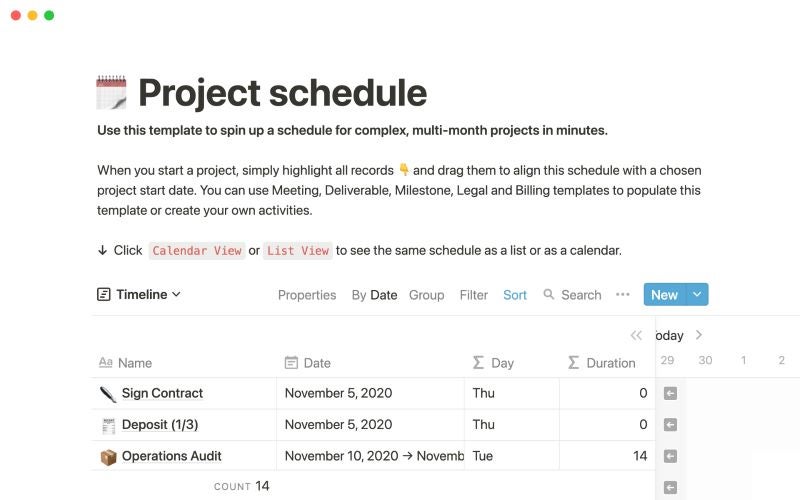
Features
- Extensive note-taking: Notion is known for its note-taking and organizing capabilities, which transfer into its project management solution.
- Creative workflow templates: Workflow templates in Notion allow for organized and structured workflows.
- Recurring tasks and reminders: Notion’s recurring tasks and reminders ensure that important tasks and dates are always at the forefront.
- AI assistant: Notion AI can automate tasks, improve writing and provide creative suggestions.
Integrations
- Asana: Bring in tasks to Notion to get regular updates on projects from different teams.
- Dovetail: View customer insights, data and projects directly on Notion.
- Make: Build, design and automate workflows.
| Pros | Cons |
|---|---|
|
|
For more information, read the full Notion review.
Adobe Workfront: Best for Adobe product users
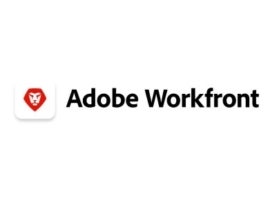
Adobe is a leader in the cloud software field, and Workfront is an excellent example of why. The platform makes collaboration easy, is fast and responsive, offers multiple customization options and integrates seamlessly with other Adobe Cloud products.
Workfront includes tools supporting a wide range of collaborative approaches, including scrum and Kanban. Similarly, it has a vast array of templates and reporting features. Navigating between all of these features can be complicated at times, though.
Why we chose Adobe Workfront
Adobe Workfront gives teams a centralized platform for project scheduling and management. Project request and approval workflows streamline projects and ensure each task is appropriately assigned and worked on. The integration with Adobe’s creative tools makes it easier for team members to collaborate on designs and other aspects of larger projects.
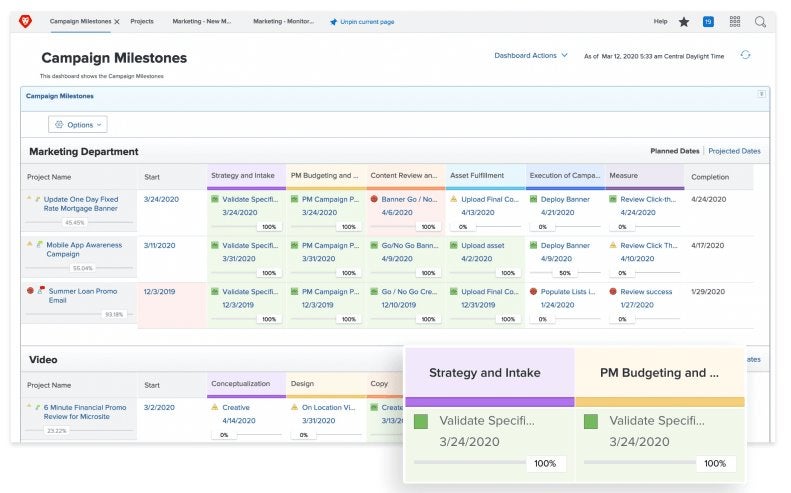
Pricing
Adobe Workfront does not make pricing for its Select, Prime or Ultimate plans readily available. Those interested will need to contact Adobe for pricing details.
Features
- Workflow automation: Automated workflows streamline project progress.
- Reporting dashboards: Real-time reports and dashboards offer accurate project progress tracking.
- Report templates: Templates allow for streamlined yet customized reporting.
- Scenario planning: The Scenario Planner tool updates projects using feedback to provide project guidance.
Integrations
- Salesforce: Improve sales cycle efficiency and assign customer service tasks to team members.
- Microsoft Outlook: Create emails into tasks and assign them to different team members.
- Box: Attach Box files to your projects and tasks for easier collaboration.
| Pros | Cons |
|---|---|
|
|
For more information, read the full Adobe Workfront review.
TeamGantt: Best for large teams
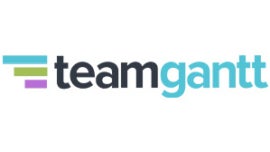
As its name implies, TeamGantt focuses on Gantt charts, making it easy to get an overall picture of project timelines. These allow for easy tracking of tasks and sub-tasks, and the platform also has places to keep all your communication and documents together for higher efficiency.
TeamGantt is entirely cloud-based and has a dedicated mobile app to make it more accessible. Unlike most project management scheduling software, it charges by manager, not by user, which can keep costs low for larger teams. It’s also remarkably easy to use, but it’s not as feature-rich as other options.
Why we chose TeamGantt
TeamGantt’s chart visualization makes it easier for project managers to plan, schedule and track tasks. By setting milestones and timelines, teams can accurately work towards project completion in an easy-to-follow manner. The simple drag-and-drop interface allows for easy scheduling adjustment, which is ideal for more dynamic workflows.
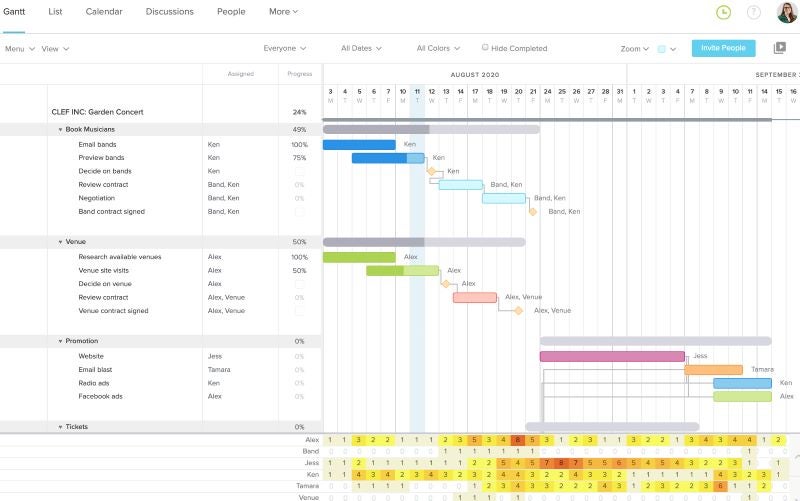
Pricing
- Free: No cost for one manager.
- Lite: $19 per manager per month, billed annually; or $24 per manager per month, billed monthly.
- Pro: $49 per manager per month, billed annually; or $59 per manager per month, billed monthly.
- Unlimited Everything: Contact the company for custom pricing.
Features
- Pay per project manager: Pricing tiers are based on the number of managers accessing the platform instead of individual users.
- Drag-and-drop interface: Managers are able to quickly and easily adjust tasks and due dates.
- Time-tracking: TeamGantt will automatically track how much time is spent on a project, so you don’t have to track it yourself.
- Planned versus actual timeline comparison: View how on-track projects are by comparing current progress to the original timeline.
Integrations
- Trello: Connect Trello cards in a project timeline to schedule tasks.
- Dropbox: Upload and share files directly into projects and tasks.
- Zapier: Connect multiple apps to manage complex projects and sync things to one platform.
| Pros | Cons |
|---|---|
|
|
For more information, read the full TeamGantt review.
Kantata: Best for automation
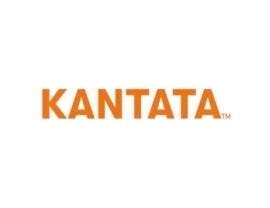
Previously known as Mavenlink, Kantata offers a slew of automated features to streamline scheduling. This automation covers everything from resource management to expense tracking to critical path analysis.
Smaller teams may not need all of these in-depth features, but those with more complex needs can save considerable time and money.
Why we chose Kantata
Kantata is simple-to-use software that can easily be picked up and integrated into a team of any size. The project scheduling tool is stable and gives project managers a convenient way to keep track of tasks being worked on. Users are also able to see project burn rates to gauge the progress of a project.
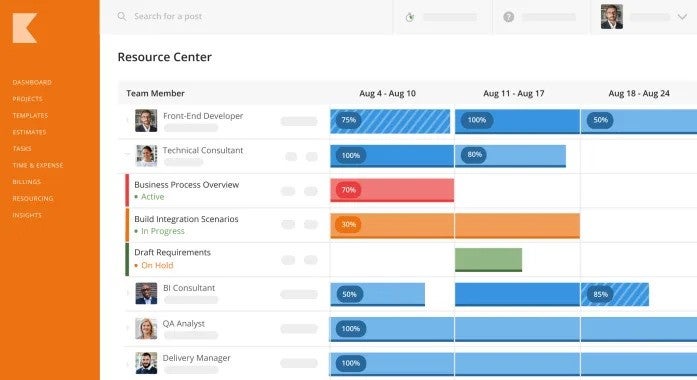
Pricing
Kantata doesn’t make its pricing details readily available. Those interested will need to contact Kantata’s sales team for pricing details or fill out the web form located on its pricing page.
Features
- Automated business intelligence: Built-in business intelligence tools provide important data and analysis.
- Resource forecasting: Users can manage and adjust talent availability on important projects.
- Built-in reports: Kantata’s built-in reporting provides real-time analytics on project progress.
Integrations
- HubSpot: Receive data and integrate it into tasks and project workflows.
- Quickbooks: Manage payroll and tax information within your software.
- Slack: Communicate with team members in real-time and stay up to date on projects.
| Pros | Cons |
|---|---|
|
|
Celoxis: Best for complicated or high-uncertainty situations

Projects in the real world rarely play out as they do on paper, and Celoxis takes that into consideration. Dynamic project planning and tools like what-if analysis and risk tracking let you adapt your schedules as necessary to changing conditions.
Automated features make it even easier to adjust to unforeseen circumstances, which is ideal for industries with high volatility, like construction or supply chain management. While it’s not the most user-friendly app available, it is one of the most powerful.
Why we chose Celoxis
Celoxis is designed for complex project scenarios. Its advanced scheduling tools make it ideal for intricate projects with the need for multiple steps, iterations and feedback from several team members. Interactive Gantt charts allow you to see detailed insights on schedules and task dependencies and aid in a more optimal project plan.
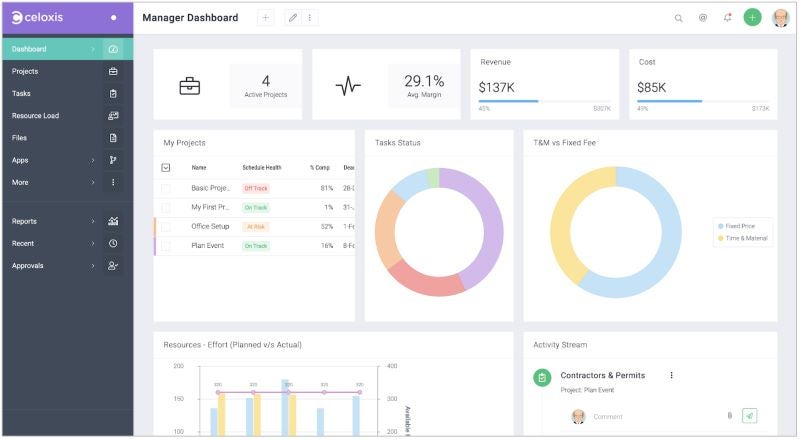
Pricing
Though Celoxis doesn’t advertise its rates on its website, the company offers two pricing editions — cloud and on-premise. It charges you on a per use basis. Contact the company to get a custom quote.
Features
- Dynamic dashboards: Dashboards can be customized for different roles as well as clients to portray the most relevant information.
- Time and expense tracking: Celoxis timesheets can track time spent on projects as well as current progress on projects.
- Risk management: Celoxis allows users to assess risk throughout the project timeline.
- Automatic alerts: Important project alerts and notifications will automatically be generated.
Integrations
- Jira: Create and track issues on Jira and then connect them to tasks in Celoxis.
- Salesforce: Assign and manage customer projects.
- Okta: Save time with a password manager for all team members.
| Pros | Cons |
|---|---|
|
|
For more information, read the full Celoxis review.
Parallax: Best for predictive resource management

Parallax project scheduling software helps full-service digital agencies, software development firms, digital marketing companies and technology consultants plan and manage their projects by offering resource allocation, capacity management, financial tracking and operational intelligence. It allows managers to properly assign resources to tasks, track project timelines, monitor project budgets and gain insights into their project operations.
Why we chose Parallax
Parallax stands out for its forecasting feature, as it allows users to plan and allocate resources for upcoming projects based on historical data and predictive analytics.
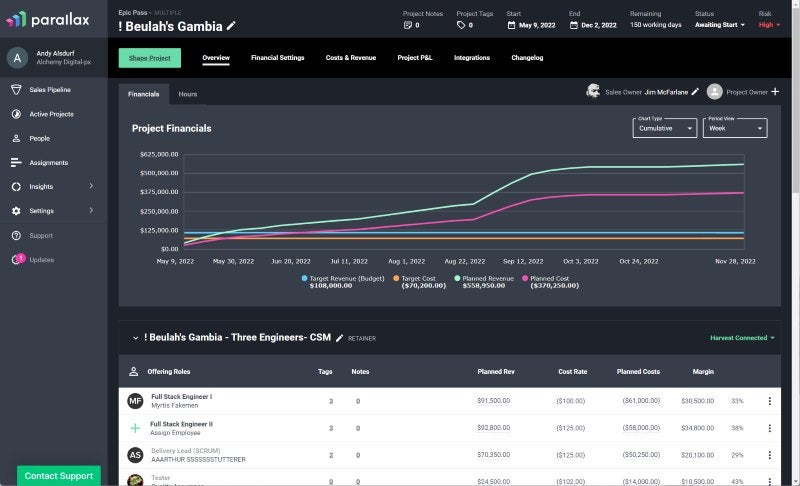
Pricing
Parallax doesn’t advertise its rates on its website. Our research found that it charges per billable resource. Contact the company for your actual quote.
Features
- Forecasted capacity planning: Parallax provides insights into resource availability and capacity, helping PM allocate tasks to team members based on their availability and workload.
- Resource planning and management: It assigns resources to a project using forecasts on incoming demand.
- Project financials: This feature allows users to track and manage project budgets, expenses and financial metrics. Users can input budget estimates, track actual costs and analyze project profitability.
Integrations
- CRM tool integrations: Parallax integrates with various customer relationship management solutions, including Salesforce, HubSpot, Copper, Pipedrive, monday.com and Zoho.
- Integrations with project management tools: Connects with PM tools like Asana, Notion and monday.
| Pros | Cons |
|---|---|
|
|
Runn: Best for IT, architecture and engineering teams
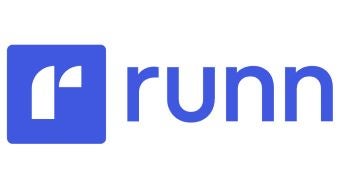
Runn helps growing IT and software teams, as well as architecture and engineering teams, plan, track and manage their projects and resources with ease. The software allows you to allocate resources, create project plans, track progress and gain insights into your team’s workload and availability. It offers resource planning, project scheduling and reporting features to help businesses optimize their project management process and improve productivity.
Why we chose Runn
Our research found that Runn provides real-time insights into project timelines, capacity planning and resource utilization, facilitating efficient project execution and improved team collaboration.
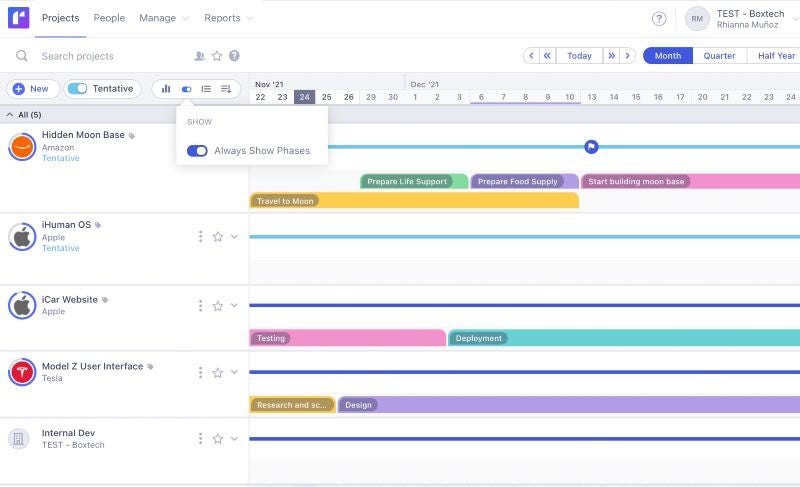
Pricing
- Free plan: No cost for up to 5 people.
- Pro: $8 per person managed per month, billed annually; or $10 per person managed per month, billed monthly.
- Enterprise: Quote available upon request.
Features
- Resource scheduling: It allows you to view the availability and utilization of resources across different projects and timelines.
- Project forecasting: It lets you forecast your team’s capacity and track your projects and pipeline, allowing you to prepare for potential delays and changes before they arise.
- Capacity management: This feature enables teams to ensure that they have the right resources available at the right time, avoiding overallocation or underutilization.
- Reporting: Runn generates comprehensive reports on resource usage, allowing teams to understand resource allocation patterns.
Integrations
As of the time of writing, Runn only connects with human resources and time tracking tools.
- HR integrations: You can connect Runn with AlexisHR, BambooHR and CharlieHR.
- Time tracking: Runn’s integration with Clockify and Harvest makes it easy to sync time-tracking data from these tools into Runn.
| Pros | Cons |
|---|---|
|
|
Nifty: Best for managing task dependencies and milestones
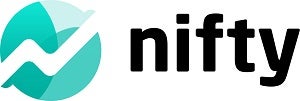
NiftyPM is a project management tool that lets teams plan, schedule, track and collaborate on their projects. It streamlines project workflows and improves team productivity by providing a centralized platform for project management.
Nifty offers visual project planning tools such as project timelines and milestones. These visual representations help teams understand project progress, dependencies and critical paths, allowing for better project management.
Why we chose Nifty
Nifty’s ability to manage milestone dependencies can be a critical factor for organizations with complex projects requiring clear sequencing and interdependence between tasks and milestones.
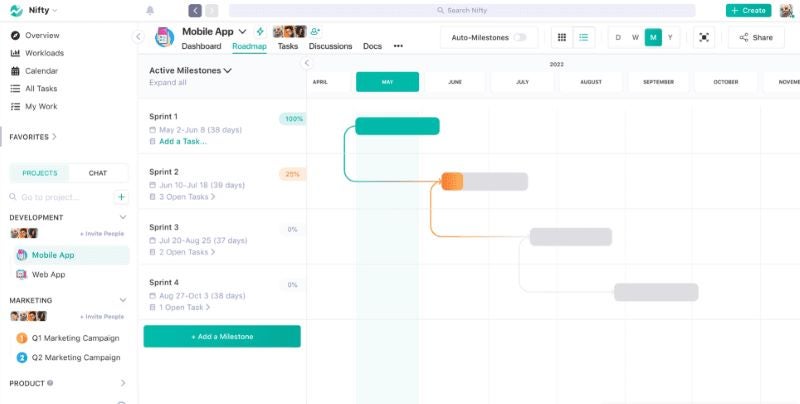
Pricing
14-day free trial available.
- Free: No cost for unlimited team members.
- Starter: $39 per month, billed annually; or $49 per month, billed monthly. Up to 10 members.
- Pro: $79 per month, billed annually; or $99 per month, billed monthly. Up to 20 members.
- Business: $124 per month, billed annually; or $149 per month, billed monthly. Up to 50 members.
- Unlimited: $399 per month, billed annually; or $499 per month, billed monthly. Unlimited members.
Features
- Task dependencies: Ensure a task can only be started or completed after its dependent tasks have been completed.
- Goals tracking: Automatically track KPI across projects, teams and individuals.
- Priority support: Nifty provides priority support for Business and Unlimited plan users.
- Time tracking capability: This lets you track each team member’s time on their tasks.
- Milestone dependencies: Nifty PM allows you to establish relationships between different project milestones.
Integrations
- Slack: Nifty’s integration with Slack allows users to receive real-time notifications, updates and task reminders directly on their Slack channels.
- Google Drive: Users can connect their Google Drive accounts with Nifty, making it easy to attach files and access relevant project documents within the platform.
- GitHub: This integration allows developers to link GitHub repositories to their Nifty projects, providing visibility and easy access to code repositories.
| Pros | Cons |
|---|---|
|
|
For more information, read the full Nifty review.
GanttPRO: Best for budget management and automatic rescheduling

GanttPRO is an online project management tool that allows users to create and manage project schedules using Gantt charts. It provides a visual representation of project tasks, dependencies and timelines. GanttPRO incorporates collaboration features that enable team members to work together on projects. Users can communicate within the tool by commenting on tasks, attaching files and mentioning teammates. It also offers features such as task management, resource management, team collaboration, progress tracking and reporting.
Why we chose GanttPRO
We selected GanttPRO as one of the best project scheduling software for its powerful Gantt chart capabilities, as it allows teams to create and manage project schedules competently. The visual representation of tasks, dependencies and timelines makes it easy to understand project progress and make necessary adjustments.
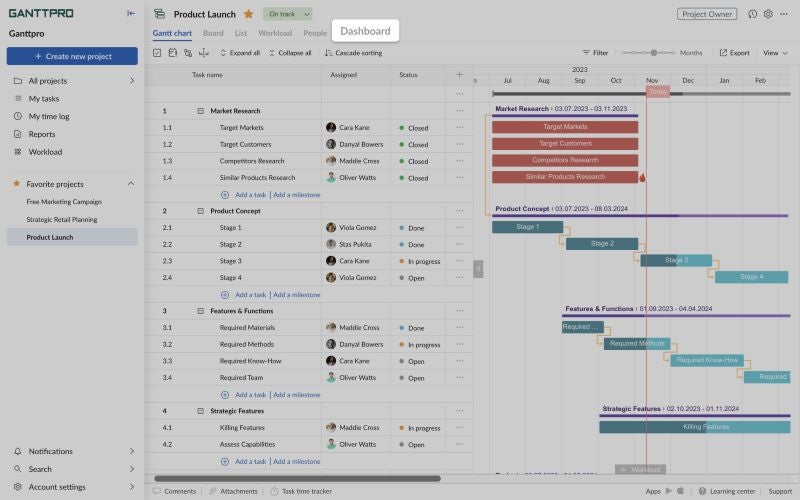
Pricing
- Basic: $7.99 per user per month, billed annually; or $9.99 per user per month, billed monthly.
- Pro: $12.99 per user per month, billed annually; or $15.99 per user per month, billed monthly.
- Business: $19.99 per user per month, billed annually; or $24.99 per user per month, billed monthly.
- Enterprise: Custom quote.
Features
- Task management: It allows you to set and view task status and priority, track progress, view history and create custom fields.
- Project views: GanttPRO has six view options, including Gantt chart, board, list, dashboard, portfolio and workload views.
- Project planning: GanttPRO features auto-scheduling, dependencies, milestones and critical paths.
Integrations
- Microsoft Teams: Users can connect their GanttPRO workspace with Microsoft Teams to facilitate collaboration and communication within projects.
- Slack: This connection lets you receive real-time notifications and updates on project activities, tasks and deadlines.
- Google Drive: This allows users to attach files and documents from their Google Drive directly to tasks and projects in GanttPRO.
- Jira: Team members can link Jira issues and tasks with GanttPRO projects, enabling synchronization between the two platforms.
| Pros | Cons |
|---|---|
|
|
For more information, read the full GanttPRO review.
Resource Guru: Best for affordability and workload management

Resource Guru is cloud-based resource management software that helps businesses efficiently schedule and manage their team’s resources. It provides a centralized platform for teams to schedule and plan their resources, such as employees, equipment and facilities. The software lets teams track resource availability, schedule and allocate resources for different projects or tasks, and get a clear overview of resource utilization and availability.
Why we chose Resource Guru
The platform prevents resource overbooking and provides real-time visibility into resource availability, allowing you to avoid conflicts and ensure optimal resource utilization.
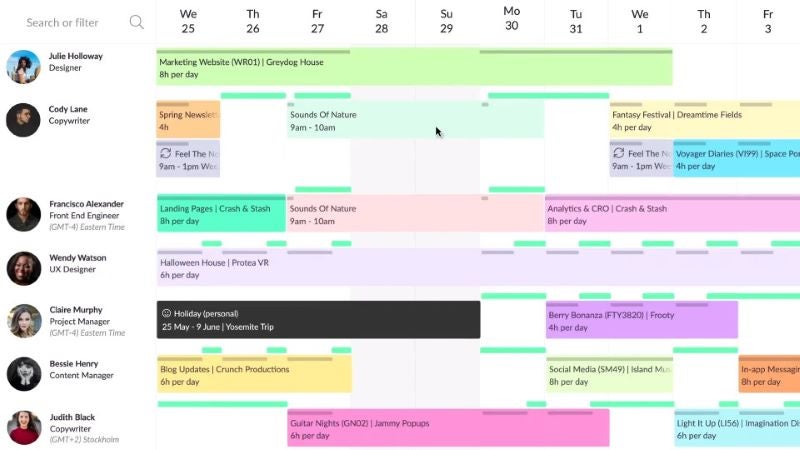
Pricing
- Grasshopper Plan: $4.16 per person per month, billed annually; or $5 per person per month, billed monthly.
- Blackbelt Plan: $6.65 per person per month, billed annually; or $8 per person per month, billed monthly.
- Master Plan: $10 per person per month, billed annually; or $12 per person per month, billed monthly.
Features
- Resource scheduling: It allows you to create and manage schedules for your team members and resources, guaranteeing that tasks and projects are properly allocated and deadlines are met.
- Resource management: It helps you track and manage your team’s availability.
- Equipment management: The platform allows you to track and manage equipment and assets.
- Project forecasting reports: Resource Guru offers detailed project forecasting reports, providing insights and analytics on resource availability, utilization and allocation.
Integrations
- Calendar integrations: Resource Guru can be integrated with calendar applications such as Google Calendar, Apple Calendar, Calendly, Fantastical and Outlook Calendar.
- Zapier: Zapier lets you connect Resource Guru with over 1,500 third-party apps, including Salesforce, Trello, Slack, Gmail, Microsoft Teams and more.
| Pros | Cons |
|---|---|
|
|
See how Resource Guru compares to other dedicated resource management tools.
Key features of project scheduling software
The most important element of a project management scheduling tool is that it lets each team member know when their various tasks are due. Having multiple project views is similarly beneficial, as are automation tools, customizable dashboards and reporting features. Some other important features include:
Work breakdown features
Building a work breakdown structure is essential for project planning. Therefore, a project management scheduling tool should include specific task assignments. This will give project managers greater control over project planning and management.
Gantt charts
While having multiple view types is a must, Gantt charts are especially beneficial, as they show an overall view of overlapping tasks and due dates to help track work breakdowns.
Integrations
Project management scheduling tools should integrate with third-party apps like document-sharing platforms or payment software. This ensures users can manage or access essential functions on a single platform, making project planning and management more efficient.
Timeline view
Your project scheduling software should have an easy way to view timelines and tasks. It should provide an interface that allows you to track the progress of multiple projects and determine who is working on what and how long until completion.
Documentation and reporting
Any good project scheduling software should provide some form of documentation and reporting. This helps project managers keep track of deliverables in one convenient place. It also allows managers to stay better organized and compile data during or at the end of a project.
How do I choose the best project scheduling software for my business?
To find the best project management scheduling software for you, start by outlining your needs. Determine your budget, number of users, other tools you use and similar factors. With this information, you can see which platforms offer the features or support you need, as well as which are the most cost-effective.
Keep your team members’ skills and experience in mind, too. Many of the most feature-rich and detailed scheduling tools require more technical expertise to use effectively. Similarly, if you must manage multiple types of projects, look for a platform with versatility and scalability.
More than 40% of information workers spend at least 25% of their time on repetitive, manual tasks and scheduling is often one of these time sinks. Consequently, it’s a good idea to prioritize software that will streamline the tasks your team spends the most time on.
Methodology
To compile this list, we started with some of the most popular project management scheduling tools across teams and industries. We then used user reviews and combed through product pages to compare features, prices, user impressions and ideal use cases. The order of the list is arbitrary, not reflecting any sort of ranking.




